By Soraya Nadia McDonald in the May-June 2019 Issue
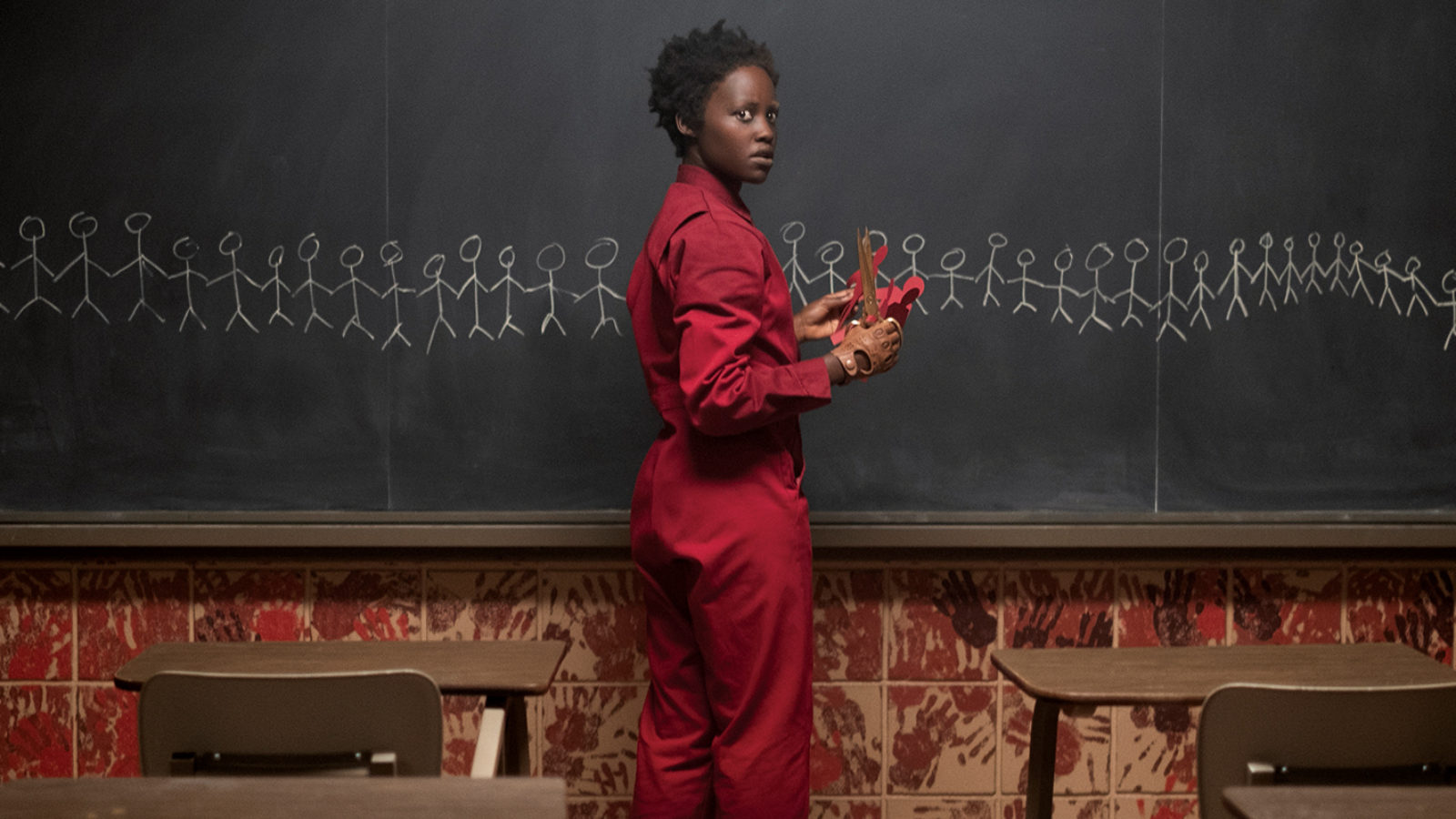
Free to Be You and Me
In Jordan Peele's second Zeitgeist-catcher, Us, the doubled characters of Adelaide and Red pose vexing, urgent questions about assimilation in America.
One of the pleasures of Us, the sophomore feature from writer-director Jordan Peele, has been just how much it continues to yield upon second, third, and fourth helpings. It is film as mille-feuille. Each of its layers offers something different, and in turn reveals something about the viewer—which is how a horror film can somehow be an allegory about capitalism, about the violence inflicted on Native Americans, about the prison-industrial complex, and about the violence inflicted by, or as a result of, assimilation.
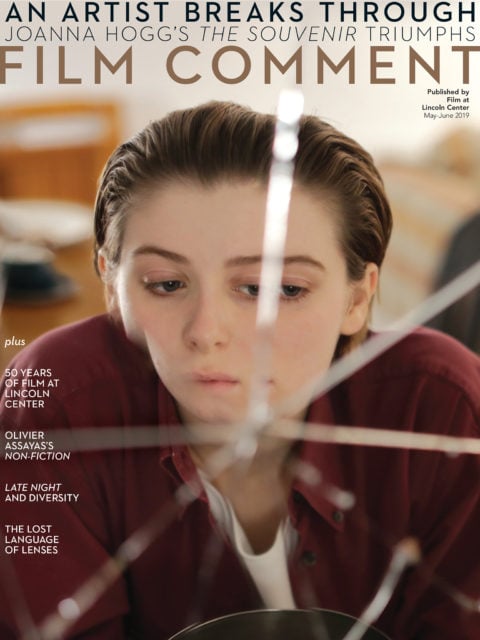
From the May-June 2019 Issue
Also in this issue
If Us is about the United States, it’s worth asking: what makes us, well, us? Why is how we define ourselves so important, especially in a country that regards itself as a melting pot of cultures, traditions, and ethnicities? And how does it affect how we think about the character of Adelaide in Us, who, as a child—the twist ending reveals—is strangled and snatched into an underground world by her diabolical double, the antiheroine played with such marvelous and anxious depth by Lupita Nyong’o? One of the things made clear by Peele, whose continued march through the culture has (so far) included a newly reimagined Twilight Zone and the YouTube Premium series Weird City, is that it’s impossible to erase all traces of who we are, even when our survival depends upon it—even when it’s what we desperately desire.
Other films have taken on assimilation centered around the immigrant experience and found different touchstones. Brooklyn, released in 2015, regards America as a place full of hope for its main character, Eilis (Saoirse Ronan). It’s a destination where she can blossom into her full self, even as she mourns the ties she must leave behind in her home country of Ireland. In Coming to America, the 1988 Eddie Murphy comedy, America is also presented as a place where an outsider can shed the obligations of his home country and embrace his fully realized self. The same is true of Kumail Nanjiani’s dramatized self in the 2017 independent hit The Big Sick.
The Wilson family of Us are not immigrants, but they are invested in an Eisenhower-era ideal of normalcy that is quickly becoming outdated: a married couple with two kids, a house, and a vacation home. They are black, and so they are Americans in a country that does not always fully regard black people as such—and thus are immigrants in their own nation, in a way. For the Wilsons, assimilation is mostly economic, finding ways to signal that they, too, are the American Dream. Hence, the stick-figure family in the back windshield of the Wilson family vehicle. Everything about them says we’re perfectly typical. We belong.
Except one of them doesn’t.
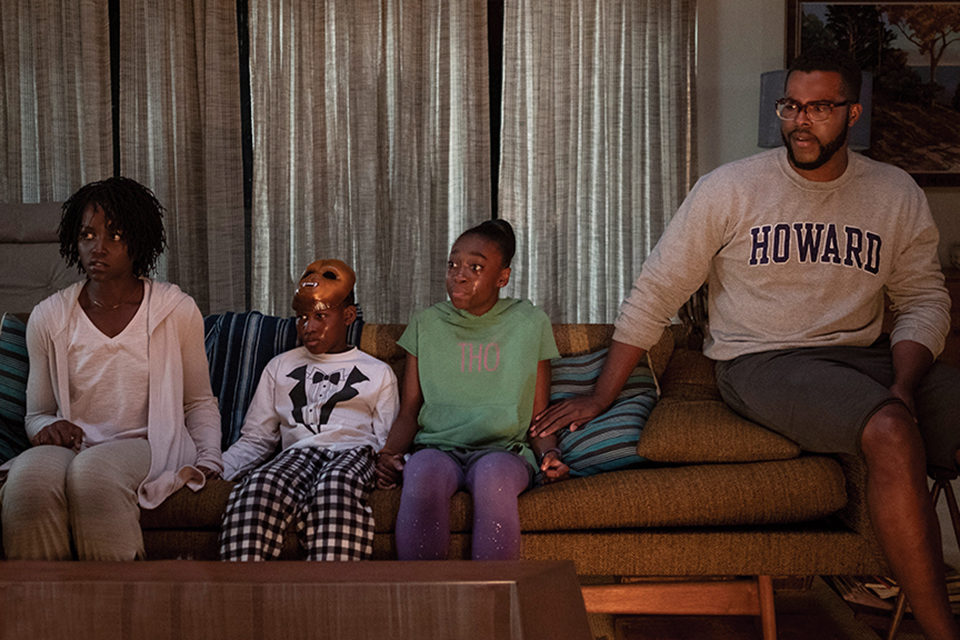
Us (Jordan Peele, 2019)
More than any other character in us, the real Adelaide illustrates the dark destructiveness that lies beneath the surface of assimilation. When as a child (in the ’80s) she wanders into a hall of mirrors, labeled as an Indian “Vision Quest” that will lead her to “find herself,” Adelaide encounters a little girl who looks exactly like her. The girl, Red, strangles Adelaide and drags her down to the underworld of the tethered, a world defined by deprivation. There’s no sunshine, no agency, no culture, no speech, and certainly no Michael Jackson. Above ground, Red assumes Adelaide’s identity. She takes the “Thriller” T-shirt Adelaide’s father had won for her only moments before, and then she slides right into Adelaide’s life. For both Adelaide and Red, assimilation involves erasure and survival.
Because of the twist ending of Us, the audience therefore spends a good three-quarters of the movie rooting for an assimilated doppelgänger. It is a mind-bending, brilliant bit of trickery on Peele’s part, one that inspires a revelation akin to the one Brad Pitt voices in Mr. & Mrs. Smith after he and Angelina Jolie come to realize they’re both spies: “We’re going to have to redo every conversation we’ve ever had.” (Note: Now that enough people have seen Us, it’s only fair to restore the names of the characters to the individuals to whom they actually belong. So for the purposes of this essay, “Red” refers to the Nyong’o we see with microlocs, clothed in white. Mentions of “Adelaide” refer to the real, original Adelaide, who emerges clad in a red jumpsuit and an unkempt Afro in the Wilsons’ driveway.)
Repeat viewings prompt a reexamination of the real Red (the kidnapper) and the real Adelaide (the kidnapped). Adelaide is perhaps seven or eight when Red snatches her and steals her identity, yet she’s already formed strong notions of who she is—ones to which she stubbornly clings for decades, even as her years among the tethered eventually outnumber the years she spent above ground. Red meanwhile must learn to do the things that go along with being Adelaide—speak, dance ballet, form connections with people—all in service of preserving the secret of her true identity. Of course, there are tells; Red never truly fits into Adelaide’s life, not completely. She cannot find the beat of Luniz’s “I Got 5 on It,” for one thing. But she does well enough that she manages to avoid suspicion.
Below ground, Adelaide plots to escape the misery of tethered life with a complicated plan that involves wreaking bloody havoc with scissors—and the 1986 Hands Across America anti-poverty campaign. But this is not just some horror-movie flourish: Adelaide uses Hands Across America because she’s clinging to things that tell her who she is. Even when forced to live a life in the shadows, Adelaide has never, ever allowed herself to forget the life that came before it. For the original Red, assimilation means becoming Adelaide seamlessly. It’s something to strive toward, a practice to be perfected with conscientiousness and repetitions. But for the real Adelaide, assimilation below ground means relinquishing her true identity. It means giving up. It means resignation and defeat.
And because she refuses to do any of those things—Adelaide is, after all, a little American black girl with a heritage of fight and resistance encoded within her very bones—she grows up to be a revolutionary.
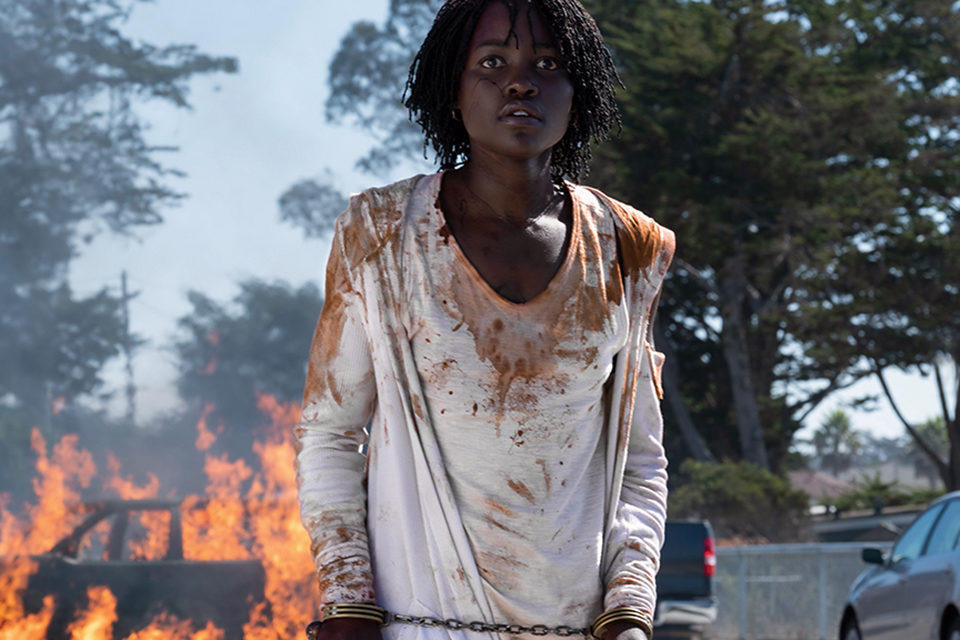
Us (Jordan Peele, 2019)
The image of a black woman as a violent, murderous revolutionary is quite rare. Adelaide is essentially the Nat Turner of the tethered. Historical memory is dominated by male revolutionaries—Simón Bolívar, Huey Newton, Stokely Carmichael, Che Guevara, George Washington. But all too often, women are consigned to positions as secretaries of social movements, not generals, Joan of Arc notwithstanding. And the orientation of Adelaide in Us—leader of a deadly nationwide campaign—is reflective of how the status quo tends to regard revolutionaries: as threats, as troublemakers, as people to be feared, resented and subdued. (In 1963, a Gallup poll of Americans revealed that 60 percent of them harbored unfavorable views of the March on Washington.)
Us puts its audience in the position of the status quo, and then it challenges our allegiances. It primes viewers to fear Adelaide, especially when we don’t understand her motivations. She’s a foreign entity with a strange voice and odd clothes, leading an army of silent, irrational-seeming red-clad killers. It is she who must assert, “We’re Americans.” She’s the one who forces all of us to confront the awfulness to which we subject those whom we’d rather disregard, even if they’re our fellow countrymen and women. She is an avatar for resistance to assimilation—escaping the loathed tethered life and also destroying the order above ground.
Then there’s Gabe. Husband to the impostor Adelaide and father of her children, Gabe Wilson (Winston Duke) is Red’s mirror opposite. He’s a giant, thick-thighed warning sign for those who become (quite literally) seduced by assimilation, who refuse to question, or even think about whose subjugation enables their comfortable, normal American existence. Gabe just wants to live a blissfully ignorant life and enjoy his boat.
Gabe’s character is defined by a constant, compulsive need to compare his family and their assets to those of his friends, the slightly wealthier Tylers (played by Tim Heidecker and Elisabeth Moss). It smacks of basic materialism, yes. But it’s also indicative of a certain sort of American Dream–chasing: one in which the pursuit of happiness is defined by the size and newness of your house and the wares it contains, the make and model of your car, and what university you attended (sometimes by any means necessary, as the notorious college admissions scandal of 2019 has revealed).
What’s interesting about Gabe is that he’s a proud alumnus of America’s most prestigious historically black university: Howard. Part of what makes Howard so special is that it infuses its students with the confidence and pride in their own blackness to resist the urge to follow or imitate white definitions of success. Instead, it encourages them to seek their own, and to be inspired by the accomplishments of the many black luminaries whose names are emblazoned all across its campus, among them Charles Drew, Frederick Douglass, Harriet Tubman, and Mary McLeod Bethune. It doesn’t allow its students to turn a blind eye to the ugliness of America’s past or even its present—Howard students are prodigious protesters. Instead, it memorializes and celebrates the resilience and mettle of African-Americans, of our traditions and shared culture.
And yet, at some point in his adult life, Gabe lost sight of this legacy. Perhaps that’s why he’s so oblivious to the little clues suggesting that something is not quite right with his wife. Gabe is so blinded by his own assimilated pursuit of happiness, by becoming the loveable, oblivious dad immortalized in the American sitcom, that he repeatedly poses a danger to himself. When he’s attacked by his own tethered double, Abraham, Gabe nearly kills himself with his own boat—the one he bought in his never-ending quest to keep up with the Tylers. Even when Red is giving off signs, Gabe is little more than a clueless stooge. His response to Red’s anxiety-ridden declaration that she doesn’t feel like herself says it all: “I think you look like yourself.”
More than anything, Gabe is obsessed with the totems that make up the language of capitalist American success-signaling. Even when the Wilsons are in life-threatening danger and his friends are laying in pools of their own blood, he can’t help but take a second to appreciate the fact that, in their bid to escape the encroaching, murderous terror of the tethers, his family gets to take Josh and Kitty’s car, which is more expensive than their own.
Gabe, too, tells us something we’d rather not face about ourselves. Full-blown crises don’t always lead to enlightened “aha!” moments (something that progressives who think a one-term Trump presidency is an inevitability might do well to remember). Sometimes all people can do is cling to what they know, even as the world is collapsing around them. If Adelaide is a personification of the hell to pay when you try to force someone into a box they never wanted to be in, Gabe is a reminder of what happens when we try to force ourselves into ill-fitting visions of white upper-middle-class cookie-cutter happiness. Eventually, we have to pay the damn piper.
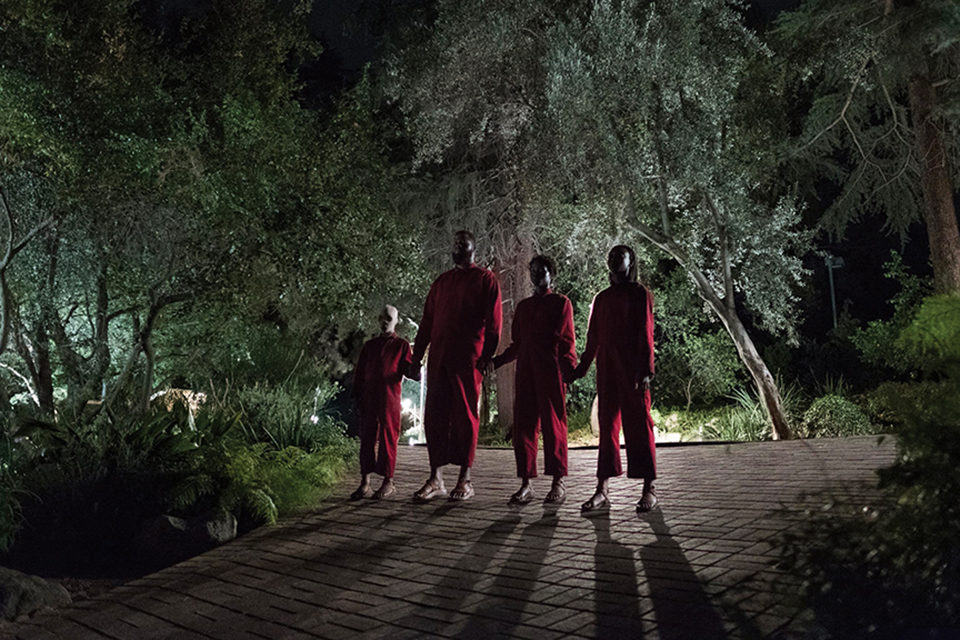
Us (Jordan Peele, 2019)
If Peele’s 2017 directorial debut, Get Out, was a film about American slavery (among other things), then Us may well be a movie that pushes its audience to think about American hegemony generally—about who pays the price for the comforts we take for granted, and about our own passive complicity in the subjugation of others. What’s more, Peele extends quite a bit of generosity to the Gabes among us. It’s safer to be oblivious, assimilated Gabe, even if it’s not necessarily ethical. After all, Gabe lives in the end. Adelaide the revolutionary does not.
Comfort is beguiling. It’s the easy choice. It always has been. Consider one of the most iconic scenes about forced assimilation in the history of the moving image: the moment in Roots when Kunta Kinte refuses to answer to the name Toby, even if it means being subjected to physical torture. There are plenty of folks who would adopt the name and forego the pain of the lash. What’s so bad about letting a few of the things that define us fall by the wayside? Can we preserve our true selves if we only whisper reminders of them in the comfort of relative safety?
A big source of illumination for the difficult questions Us prompts comes from outside the realm of movies—from theater, which has proven to be incredibly responsive to the big questions of modern-day America in a way that often eludes the film industry. Take, for a dazzlingly on-point example, the off-Broadway play Ain’t No Mo’, which recently closed at the Public Theater in New York. It offers a gut-wrenching illustration of the emotional stakes of relinquishing one’s culture, whether by forced or voluntary means.
In playwright Jordan E. Cooper’s story, African-Americans are given the opportunity to board a free one-way flight to Africa, after which they can move on to the country of origin of their choosing. And yet, unbeknownst to these passengers, the price for liberation is that they must leave behind everything that black people have given to the United States, from the blues that B.B. King created with his guitar, Lucille; to the on-screen sashays of Dorothy Dandridge; to the poetry of Phillis Wheatley; to the imagined worlds of Virginia Hamilton and Octavia E. Butler. Gone, gone, gone, gone, gone. Everything must be abandoned. If an unlucky passenger happens to waffle on their decision as they’re walking down the jetway and turns around, a supernatural force sucks them back into the States. (The soundtrack to their forced exile into a vast wasteland of whiteness is “Cotton-Eyed Joe.”) It’s not until the last flight to Africa departs from gate 1619 (the number matches the year when enslaved Africans were first brought to America) that the great tragedy is revealed.
Freedom from white supremacy may be on the other side of the journey in Ain’t No Mo’, but everything African-Americans have given to this country is, quite literally, rooted here. It can’t be pulled up and repotted like so many plants. And the one person in Cooper’s story charged with making sure all of these contributions (which have been conveniently consolidated into a kente cloth suitcase named Miss Bag) make the journey ends up missing the last flight to freedom. Try as he might, he simply cannot bear to part with Miss Bag, and Miss Bag refuses to part with America.
It’s a play that dovetails vividly with Us, and helps to illuminate the hard truths about assimilation and identity that Peele lays bare in a different but recognizable landscape. Us is daring because of its indictment of everyday people, and in an unexpected genre, horror. Why would Adelaide continue to hold fast to her ballet skills, to Hands Across America, even to the color red, which is the same as the candy apple she dropped before walking into that house of mirrors at the boardwalk? Because she’s clinging to her own rudimentary version of Miss Bag. Because she refuses to be erased.
Those elements, as small and inconsequential as they may seem, make Adelaide Adelaide. They’re how she orients herself in the world. They feed a sense of self and a sense of belonging. And nothing—not even decades of separation—can force her to part with them. That’s why she is unique among the tethered—she knows a life exists beyond the miserable, vitamin D–deficient existence that the subterranean community has have come to regard as normal. She’s rooted in a way that they are not, in a way they yearn for. What’s more, a life of deprivation has taught Adelaide the stakes of losing oneself forever. Perhaps violence is inevitable in the face of such an existential threat. It doesn’t have to be, if we recognize that difference alone is not a boogeyman. But history and its many repeated follies suggest this is a lesson that doesn’t stick.
In the final act of the film, the real Adelaide comes to the end of her journey. But her living Hands Across America art installation ensures that she never really dies, not completely, not even if her parents go to their graves unaware of the childhood switch that took place. After the hall-of-mirrors swap, a therapist advises Adelaide’s parents to draw Red out of her shell with art, with sketching, with dance. She’s encouraged to express herself, and does so in healthy, digestible ways that her newfound freedom allows.
Adelaide’s Hands Across America functions in much the same way as Red’s therapy drawings, but it is craggy, loud, and disturbed, with good reason: Hands Across America and the violence that preceded it speak in the language of the unheard, and freeze Adelaide’s garbled message in amber. Art doesn’t just ensure legacy. Even in the face of forced erasure, it keeps us alive. That may be the most valuable contribution Peele offers as a filmmaker and an artist. Even if the vision he shows us is not always flattering, it’s preserved. For better or worse, Us keeps us alive, too.
Soraya Nadia McDonald is the culture critic for The Undefeated.







